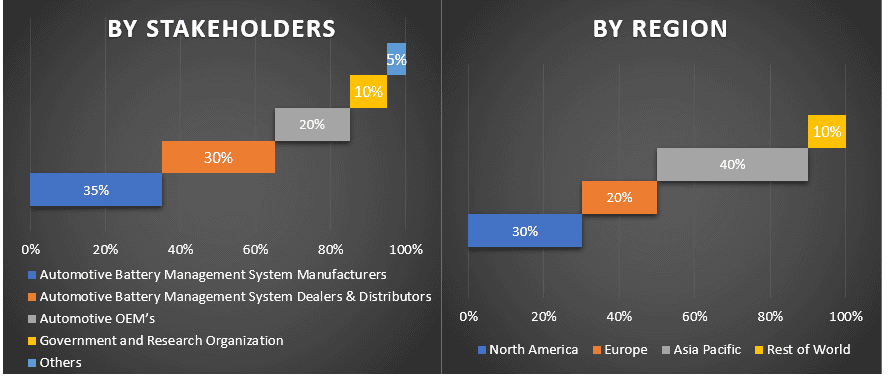- Home
- About Us
- Industry
- Services
- Reading
- Contact Us
Automotive Battery Management System Market: Current Analysis and Forecast (2021-2027)
Emphasis on Battery type Lithium Ion, Advanced Lead-acid and Others); Topology (Centralized, Modular and Distributed); Vehicle (Passenger Car and Commercial Vehicles); Region and Country

Global Automotive Battery Management System is anticipated display a CAGR of around ~17% over the forecast period (2021-2027). A vehicle’s Automotive Battery Management System is an electrical component that regulates illumination. The module helps to regulate the functioning of the headlights and horns by providing an automatic high beam. It may be changed between low and high light beam depending on the other direction for measuring the distance between the front automobiles during traffic with the use of a video camera. The market is expected to grow as manufacturers adopt Automotive Battery Management Systems, which are extremely useful while driving a vehicle, especially on the highway, where it tends to switch between low and high beam in response to oncoming traffic from the opposite direction, as well as growing concerns about road safety.
Insights Presented in the Report
“Amongst Battery Type, Lithium Ion segment dominated the market in 2020”
Based on battery type, the market is segmented into Lithium Ion, Advanced Lead-acid and Others. The Lithium Ion segment is expected to grow at a higher CAGR during the forecasted period. Lithium-ion batteries are becoming more popular as a result of its advantages such as increased power density and cheaper cost. Previously, lead-acid batteries were often utilized, but they lacked sufficient storage capacity per unit of mass. Lithium-based batteries, on the other hand, are difficult to manage because of their non-linear charge or discharge curve. If these batteries are overcharged or undercharged, they can be damaged. As a result, the automobile battery management system aids in the notification of battery shut down or the implementation of safety measures.
“Amongst Topology, Modular segment dominated the market in 2020.”
Based on topology, the market is segmented into Centralized, Modular and Distributed. The Modular segment is expected to grow at a higher CAGR during the forecasted period. Modular BMSs are gaining popularity since they provide more computational power and are safer owing to less wiring. Modular topology may be used in a variety of applications, including energy storage systems, industrial UPS, medical mobility vehicles, electric car parts, and drones.
“Amongst Vehicle, Passenger Car segment dominated the market in 2020.”
Based on vehicle, the market is segmented into Passenger Car and Light Commercial Vehicle. The Passenger Car segment is expected to grow at a higher CAGR during the forecasted period. The passenger car segment dominates the worldwide automotive BMS market, and this trend is expected to continue. The advantage can be linked to several variables, including the growing urban population and its commuting requirements. End-users choose EVs because of the growing worry about rising environmental pollution and their cheap running costs.
“Asia Pacific represents as the largest market.”
Based on the estimation, during the projection period of 2021-2027, Asia Pacific market is predicted to be the fastest-growing region in the coming years. During the projection period, it is predicted to dominate with the greatest CAGR. The high population density of nations like China and India, which account for more than 38% of the world population, is a major driver of this region’s growth. Furthermore, several beneficial government measures conducted in these regions to revitalize the car sector, which was hit by COVID-19, are expected to fuel market expansion. Furthermore, increased urbanization and smart cities are predicted to fuel EV expansion, accelerating the market for electric vehicle onboard chargers. Some of the major players operating in the market includes LG Chem, Ltd., Robert Bosch GmbH, Continental AG, Analog Devices, Inc., Intel Corporation, NXP Semiconductors NV, Renesas Electronics Corporation, Johnson Matthey, Inc., Toshiba Corporation, Midtronics, Inc. etc.
Reasons to buy this report:
- The study includes market sizing and forecasting analysis validated by authenticated key industry experts
- The report presents a quick review of overall industry performance at one glance
- The report covers an in-depth analysis of prominent industry peers with a primary focus on key business financials, product portfolio, expansion strategies, and recent developments
- Detailed examination of drivers, restraints, key trends, and opportunities prevailing in the industry
- The study comprehensively covers the market across different segments
- Deep dive regional & country-level analysis of the industry
Customization Options:
The Global Automotive Battery Management System can further be customized as per the requirement or any other market segment. Besides this, UMI understands that you may have your own business needs, hence feel free to connect with us to get a report that completely suits your requirements.
Table of Content
The “brain” of an electric vehicle’s battery pack is the automotive battery management system, and its performance has a significant impact on the vehicle’s driving range and battery life. It aids in the monitoring of battery utilization and ensuring that a battery performs at its best. By managing the battery’s operational area, balancing it, and safeguarding it, this system regulates the battery’s recharging. It is an important component of the electric vehicle (EV) powertrain since it aids in current regulation, cell balance, and battery thermal protection. Furthermore, it is critical to identify which control functions should be allocated to a battery management system in order to avoid circumstances where the vehicle’s mobility or movement is inhibited. As a result of the rising popularity of electric vehicles, the market is likely to see the development of improved automotive battery management systems throughout the forecast period.
Seek More Details About Research Methodology
Lithium-ion batteries are gaining in popularity due to many advantages such as increased power density and cheaper cost. However, there is a danger involved with using lithium-ion batteries since they are more prone to harm if left undercharged. As a result, to handle such damages, an Automotive Battery Management System may assist with battery shutdown notice and safety procedures. The Automotive Battery Management System interacts with other components to keep track of charge levels. It also aids in cell balancing, battery thermal protection, and current regulation when charging, all of which contribute to the growth of the Automotive Battery Management System Market. Furthermore, this system protects the battery as well as the vehicle while it is operating. Control functions should be allocated to the battery management system to avoid undesirable situations such as vehicle movement being hampered. As a result, the market for Automotive Battery Management Systems is developing due to the increasing use of electric cars. However, because the adoption of an Automotive Battery Management System raises the final cost of the car, demand from cost-conscious buyers falls. In some regions, a shortage of experienced people for testing and installing Automotive Battery Management Systems in vehicles is expected to limit the growth of the Automotive Battery Management System Market.
Analysis of Historical Market Size
Step 1: In-Depth Study of Secondary Sources:
Detailed secondary study was conducted to obtain the historical market size of the Automotive Battery Management System through company internal sources such as annual report & financial statements, performance presentations, press releases, etc., and external sources including journals, news & articles, government publications, competitor publications, sector reports, third-party database, and other credible publications.
Step 2: Market Segmentation:
After obtaining the historical market size of the Automotive Battery Management System, we conducted a detailed secondary analysis to gather historical market insights and share for different segments & sub-segments for major regions. Major segments included in the report are by battery type, topology, vehicle. Further regional & country-level analyses were conducted to evaluate the overall adoption of the Automotive Battery Management System in the global context.
Step 3: Factor Analysis:
After acquiring the historical market size of different segments and sub-segments, we conducted a detailed factor analysis to estimate the current market size. Further, we conducted factor analysis using dependent and independent variables such as growing government incentives and demand for eco-friendly transportations etc. Historical trends and their year-on-year impact on the market size and share was analyzed. Demand and supply side scenario was also thoroughly studied.
Current Market Size Estimate & Forecast
Current Market Sizing: Based on actionable insights from the above 3 steps, we arrived at the current market size, key players in the Market, and market shares of the segments and company. All the required percentage split, and market breakdowns were determined using the above-mentioned secondary approach and were verified through primary interviews.
Estimation & Forecasting: For market estimation and forecast, weights were assigned to different factors including drivers & trends, restraints, and opportunities available for the stakeholders. After analyzing these factors, relevant forecasting techniques i.e., bottom-up approach was applied to arrive at the market forecast to 2027 for different segments and subsegments across the major regions globally. The research methodology adopted to estimate the market size encompasses:
- The industry’s market size, in terms of value (US$) and the adoption rate of Automotive Battery Management System across the major markets
- All percentage shares, splits, and breakdowns of market segments and sub-segments
- Key players in the Automotive Battery Management System in terms of products offered. Also, the growth strategies adopted by these players to compete in the fast-growing market.
Market Size and Share Validation
Primary Research: In-depth interviews were conducted with the Key Opinion Leaders (KOLs) including Top Level Executives (CXO/VPs, Sales Head, Marketing Head, Operational Head, and Regional Head, Country Head, etc.) across major countries. Primary research findings were then summarized, and statistical analysis was performed to prove the stated hypothesis. Inputs from primary research were consolidated with secondary findings, hence turning information into actionable insights.
Split of Primary Participants in Different Regions

Market Engineering
Data triangulation technique was employed to complete the overall market estimation and to arrive at precise statistical numbers of each segment and sub-segment of the Automotive Battery Management System. Data was split into several segments & sub-segments post studying various parameters and trends in the areas of service type, vehicle type, and region.
The main objective of the Automotive Battery Management System Study
The current & future market trends of Automotive Battery Management System were pinpointed in the study. Investors can gain strategic insights to base their discretion for investments from the qualitative and quantitative analysis performed in the study. Current and future market trends would determine the overall attractiveness of the market at a regional & country level, providing a platform for the industrial participant to exploit the untapped market to benefit as a first-mover advantage. Other quantitative goals of the studies include:
- Analyze the current and forecast market size of Automotive Battery Management System in terms of value (US$). Also, analyze the current and forecast market size of different segments and sub-segments
- Segments in the study include type, application, and vehicle
- Defined analysis of the regulatory framework for the Global Automotive Battery Management System industry
- Analyze the value chain involved with the presence of various intermediaries, along with analyzing customer and competitor behaviors of the industry
- Analyze the current and forecast market size of the Automotive Battery Management System for the major regions & countries
- Major regions studied in the report include North America (US, Canada, Rest of North America), Europe (Germany, United Kingdom, France, Italy, Rest of Europe), Asia Pacific (China, Japan, India, South Korea, Rest of Asia-Pacific), and Rest of World
- Company profiles of the Automotive Battery Management System players and the growth strategies adopted by them to sustain in the fast-growing market
Deep dive regional & country level analysis of the industry
Related Reports
Customers who bought this item also bought










